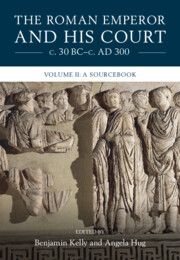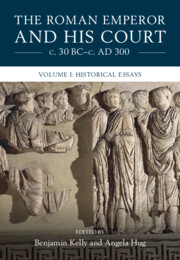Refine search
Actions for selected content:
23990 results in Ancient history
Chapter 8 - Viticulture versus Arboriculture
-
- Book:
- Plants, Politics and Empire in Ancient Rome
- Published online:
- 06 October 2022
- Print publication:
- 13 October 2022, pp 276-297
-
- Chapter
- Export citation
Chapter 4 - Grafting Glory
-
- Book:
- Plants, Politics and Empire in Ancient Rome
- Published online:
- 06 October 2022
- Print publication:
- 13 October 2022, pp 130-176
-
- Chapter
- Export citation
Chapter 1 - Roman Gardens, Representation, and Politics
-
- Book:
- Plants, Politics and Empire in Ancient Rome
- Published online:
- 06 October 2022
- Print publication:
- 13 October 2022, pp 17-49
-
- Chapter
- Export citation
Tables
-
- Book:
- Plants, Politics and Empire in Ancient Rome
- Published online:
- 06 October 2022
- Print publication:
- 13 October 2022, pp xi-xi
-
- Chapter
- Export citation
Chapter 3 - The Augustan ‘Horticultural Revolution’
-
- Book:
- Plants, Politics and Empire in Ancient Rome
- Published online:
- 06 October 2022
- Print publication:
- 13 October 2022, pp 88-129
-
- Chapter
- Export citation

Plants, Politics and Empire in Ancient Rome
-
- Published online:
- 06 October 2022
- Print publication:
- 13 October 2022

The Roman Emperor and his Court c. 30 BC–c. AD 300
-
- Published online:
- 29 September 2022
- Print publication:
- 20 October 2022

The Roman Emperor and his Court c. 30 BC–c. AD 300
-
- Published online:
- 29 September 2022
- Print publication:
- 20 October 2022
Dedication
-
- Book:
- Herodotus: <i>Histories</i> Book I
- Print publication:
- 15 September 2022, pp v-vi
-
- Chapter
- Export citation
Indexes
-
- Book:
- Herodotus: <i>Histories</i> Book I
- Print publication:
- 15 September 2022, pp 515-536
-
- Chapter
- Export citation
Chapter Four - Bronze Age Long-Distance Exchange, Secret Societies, Rock Art, and the Supra Regional Interaction Hypothesis
- from Part I - Exchange and Social Evolution: Forms of Trade in Egalitarian, Transegalitarian, and Chiefdom Societies
-
-
- Book:
- Trade before Civilization
- Published online:
- 25 August 2022
- Print publication:
- 15 September 2022, pp 53-74
-
- Chapter
- Export citation
Chapter Twelve - Value and the Articulation of Modes of Re-Production
- from Part IV - Marxian And Post-Colonial Approaches as well as World System Theory in Relation to Gift Exchange and MacroRegional Exchange
-
-
- Book:
- Trade before Civilization
- Published online:
- 25 August 2022
- Print publication:
- 15 September 2022, pp 289-308
-
- Chapter
- Export citation
Contents
-
- Book:
- Trade before Civilization
- Published online:
- 25 August 2022
- Print publication:
- 15 September 2022, pp v-viii
-
- Chapter
- Export citation
Chapter Two - Funnel Beaker Societies and Long-Distance Trade
- from Part I - Exchange and Social Evolution: Forms of Trade in Egalitarian, Transegalitarian, and Chiefdom Societies
-
-
- Book:
- Trade before Civilization
- Published online:
- 25 August 2022
- Print publication:
- 15 September 2022, pp 23-39
-
- Chapter
- Export citation
Part IV - Marxian And Post-Colonial Approaches as well as World System Theory in Relation to Gift Exchange and MacroRegional Exchange
-
- Book:
- Trade before Civilization
- Published online:
- 25 August 2022
- Print publication:
- 15 September 2022, pp 287-382
-
- Chapter
- Export citation
Chapter Thirteen - Entrepreneurs, Metals and Change
- from Part IV - Marxian And Post-Colonial Approaches as well as World System Theory in Relation to Gift Exchange and MacroRegional Exchange
-
-
- Book:
- Trade before Civilization
- Published online:
- 25 August 2022
- Print publication:
- 15 September 2022, pp 309-333
-
- Chapter
- Export citation
Contents
-
- Book:
- Herodotus: <i>Histories</i> Book I
- Print publication:
- 15 September 2022, pp vii-vii
-
- Chapter
- Export citation
Chapter Six - Middle Bronze Age Long-Distance Exchange
- from Part II - The Role That Specific Institutions And Agents Played in Long-Distance Exchange
-
-
- Book:
- Trade before Civilization
- Published online:
- 25 August 2022
- Print publication:
- 15 September 2022, pp 109-141
-
- Chapter
- Export citation
Part II - The Role That Specific Institutions And Agents Played in Long-Distance Exchange
-
- Book:
- Trade before Civilization
- Published online:
- 25 August 2022
- Print publication:
- 15 September 2022, pp 107-206
-
- Chapter
- Export citation
Chapter Fourteen - Long-Distance Interaction in Fourth Millennium bce Eurasia
- from Part IV - Marxian And Post-Colonial Approaches as well as World System Theory in Relation to Gift Exchange and MacroRegional Exchange
-
-
- Book:
- Trade before Civilization
- Published online:
- 25 August 2022
- Print publication:
- 15 September 2022, pp 334-360
-
- Chapter
- Export citation
